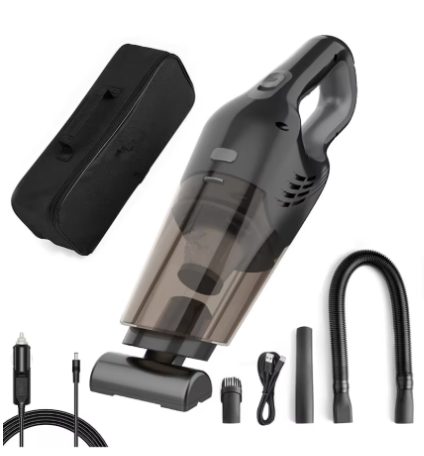Essential Care for Your Vehicle and Home Cleaning Companion
A well-maintained car home vacuum cleaner is the cornerstone of keeping both your vehicle and living spaces pristine. Whether you're dealing with pet hair, food crumbs, or everyday dirt, understanding how to properly care for your car home vacuum cleaner ensures optimal performance and longevity. This comprehensive guide will walk you through everything you need to know about maintaining your versatile cleaning companion.
Modern car home vacuum cleaners combine powerful suction with portable convenience, making them indispensable for both automotive and household cleaning tasks. However, like any appliance, they require regular maintenance to continue performing at their best. Let's explore the essential aspects of vacuum maintenance that will help you maximize your investment and achieve superior cleaning results.
Components and Maintenance Basics
Understanding Your Vacuum's Architecture
Every car home vacuum cleaner consists of several key components that work together to deliver effective cleaning power. The main elements include the motor unit, filter system, dust container, and various attachments. Each part plays a crucial role in the overall functionality of your vacuum, and understanding their purposes helps in providing appropriate maintenance.
The motor unit serves as the heart of your car home vacuum cleaner, generating the suction power needed for effective cleaning. The filter system, typically consisting of multiple layers, prevents dust and debris from reaching the motor while ensuring clean air output. The dust container collects all the captured dirt, while attachments enable versatile cleaning applications for different surfaces and spaces.
Regular Inspection Protocol
Developing a consistent inspection routine is vital for maintaining your car home vacuum cleaner's performance. Start by examining the exterior for any damage or loose components. Check all connections and attachments for secure fit and proper function. Pay special attention to power cords or charging ports, depending on whether your model is corded or cordless.
Regular inspections help identify potential issues before they become serious problems. Look for signs of wear on brushes, check for clogs in the suction pathway, and ensure all seals are intact. This proactive approach to maintenance can significantly extend your vacuum's lifespan and maintain its cleaning efficiency.
Filter Maintenance and Replacement
Cleaning Different Filter Types
Car home vacuum cleaners typically feature multiple filter types, each requiring specific cleaning approaches. HEPA filters need gentle handling and regular replacement, while foam filters can usually be washed and reused. Understanding the proper cleaning method for each filter type is crucial for maintaining optimal performance and preventing damage.
When cleaning washable filters, use lukewarm water without harsh detergents. Allow filters to dry completely before reinstallation - typically 24 to 48 hours. For non-washable filters, regular replacement according to the manufacturer's schedule is essential for maintaining proper suction and filtration efficiency.
Optimal Filter Replacement Schedule
Creating and following a filter replacement schedule ensures consistent performance from your car home vacuum cleaner. Most manufacturers recommend replacing primary filters every three to six months, depending on usage frequency and conditions. HEPA filters typically require replacement every six to twelve months.
Keep track of your filter maintenance history and set reminders for future replacements. Consider factors like pet ownership, allergy sensitivity, and cleaning frequency when determining your ideal replacement schedule. Using genuine replacement filters helps maintain your vacuum's warranty and ensures optimal performance.
Power System Optimization
Battery Care for Cordless Models
For cordless car home vacuum cleaners, battery maintenance is crucial for sustained performance. Modern lithium-ion batteries benefit from regular, complete charging cycles and proper storage conditions. Avoid exposing the battery to extreme temperatures and maintain a partial charge during extended storage periods.
Monitor battery performance and charging time to identify potential degradation. Most quality batteries should maintain effective performance for two to three years with proper care. When replacement becomes necessary, always use manufacturer-approved batteries to ensure safety and compatibility.
Power Cord and Connection Care
Corded car home vacuum cleaner models require attention to power cord maintenance. Regularly inspect the cord for damage, wear, or exposed wiring. Proper cord storage prevents kinking and extends cord life - avoid wrapping the cord too tightly or using excessive force when storing.
Keep power connections clean and free from debris. Check plug prongs for signs of wear or damage, and ensure proper connection to power outlets. Address any electrical issues promptly to maintain safety and performance.
Cleaning Performance Enhancement
Brush Roll Maintenance
The brush roll is critical for effective carpet and upholstery cleaning in your car home vacuum cleaner. Regular cleaning removes tangled hair, threads, and debris that can impair rotation and reduce cleaning effectiveness. Use scissors or the manufacturer's cleaning tool to carefully remove wrapped materials.
Inspect brush roll bearings and drive belt condition during cleaning. Replace worn belts promptly to maintain proper brush roll operation. Some models feature removable brush rolls for easier maintenance - take advantage of this feature when available.
Suction Path Optimization
Maintaining clear suction paths ensures optimal cleaning performance. Regularly check for and remove blockages in hoses, tubes, and attachments. Pay special attention to connection points where debris can accumulate. Clean these areas using appropriate tools provided by the manufacturer.
Monitor suction performance during use and address any sudden drops in power promptly. Sometimes, simply emptying the dust container and cleaning filters can restore full suction power. For persistent issues, inspect the entire suction pathway for hidden obstructions.
Frequently Asked Questions
How often should I clean my car home vacuum cleaner filters?
For optimal performance, clean washable filters every 2-4 weeks and replace disposable filters every 3-6 months. Heavy use or pet households may require more frequent maintenance. Always check your specific model's manual for recommended cleaning intervals.
What signs indicate my vacuum needs professional servicing?
Consider professional servicing if you notice persistent loss of suction, unusual noises, burning smells, or mechanical issues that basic maintenance doesn't resolve. Also, if your car home vacuum cleaner is still under warranty, professional servicing may be required to maintain coverage.
How can I maximize the lifespan of my vacuum's battery?
To extend battery life, avoid completely draining the battery before recharging, store the vacuum at room temperature, and use only manufacturer-approved charging equipment. Regular use is better for the battery than long periods of storage, and avoid charging in extremely hot or cold conditions.

